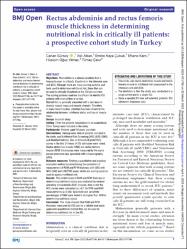Rectus abdominis and rectus femoris muscle thickness in determining nutritional risk in critically ill patients: a prospective cohort study in Turkey
Künye
Gürsoy C, Alkan A, Kaya Çubuk E, et al. Rectus abdominis and rectus femoris muscle thickness in determining nutritional risk in critically ill patients: a prospective cohort study in Turkey. BMJ Open 2023;13:e071796. doi:10.1136/bmjopen-2023-071796Özet
Objectives: Malnutrition is a clinical condition that is frequently seen in critically ill patients in the intensive care unit (ICU). Although there are many scoring systems and tools used to determine nutritional risk, those that can be used in critically ill patients in the ICU are very few. The scoring systems used are insufficient to identify ICU patients with malnutrition or at risk.Malnutrition is generally presented with a decrease in skeletal muscle mass and muscle strength. Therefore, in many recent studies, attention has been drawn to the relationship between nutritional status and loss of muscle mass.
Design: A cohort study.
Setting: Forty-five patients hospitalised in an anaesthesia ICU in Turkey were included in the study.
Participants: Patients aged 18 years and older.
Interventions: Demographic data of patients included in the study, and Nutritional Risk Screening 2002 (NRS-2002) and Modified Nutrition Risk in Critically ill (mNUTRIC) scores in the first 24 hours of ICU admission were noted. Rectus abdominis muscle (RAM) and rectus femoris muscle (RFM) thicknesses were measured by the same person (intensive care specialist) with ultrasonography (USG).
Outcome measures: Finding a quantitative and practical evaluation method by determining the correlation of measurement of RAM and RFM thickness with USG with NRS-2002 and mNUTRIC score, which are scoring systems used to assess nutritional risk.
Results: The performance of RAM and RFM thickness in determining nutritional status was evaluated by receiver operating characteristic (ROC) analysis. Area under the ROC curves were calculated as >0.7 for RFM and RAM measurements (p<0.05). Specificity and sensitivity percentages of RAM were found to be higher than RFM in determining nutritional status.
Conclusion: This study showed that RAM and RFM thickness measured by USG can be a reliable and easily applicable quantitative method that can be used to determine nutritional risk in the ICU.


















